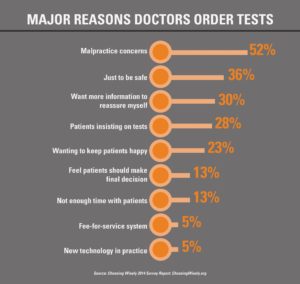Overly aggressive care can hurt patients, generating mistakes and injuries believed to cause 30,000 deaths each year.
From Kaiser Health News, May 24, 2017.
It’s common knowledge in medicine: Doctors routinely order tests on hospital patients that are unnecessary and wasteful.

There are plenty of opportunities to trim waste in America’s $3.4 trillion health care system, but it’s often not as simple as it seems.
Some experts estimate that at least $200 billion is wasted annually on excessive testing and treatment. This overly aggressive care also can harm patients, generating mistakes and injuries believed to cause 30,000 deaths each year.
“The changes that need to be made don’t appear unrealistic, yet they seem to take an awful lot of time,” said Dr. Jeff Rideout, chief executive of the Integrated Healthcare Association, an Oakland, Calif., nonprofit group that promotes quality improvement. “We’ve been patient for too long.”
In California, that sense of frustration has led three of the state’s biggest health care purchasers to band together to promote care that’s safer and more cost-effective. The California Public Employees’ Retirement System (CalPERS), the Covered California insurance exchange and the state’s Medicaid program, known as Medi-Cal — which collectively serve more than 15 million patients — are leading the initiative.
Progress may be slow, but there have been some encouraging signs. In San Diego, for instance, the Sharp Rees-Stealy Medical Group said it cut unnecessary lab tests by more than 10 percent by educating both doctors and patients about overuse.
A large public hospital, Los Angeles County-University of Southern California Medical Center, eliminated preoperative testing deemed superfluous before routine cataract surgery. As a result, patients on average received the surgery six months sooner.
These efforts were sparked by the Choosing Wisely campaign, a national effort launched in 2012 by the American Board of Internal Medicine (ABIM) Foundation. The group asked medical societies to identify at least five common tests or procedures that often provide little benefit.
The campaign, also backed by Consumer Reports, encourages medical providers to hand out wallet-sized cards to patients with questions they should ask to determine whether they truly need a procedure.
Critics have knocked Choosing Wisely for playing it too safe and not going after some of the more lucrative procedures, such as certain spine operations and arthroscopic knee surgeries.
Daniel Wolfson, chief operating officer at the ABIM Foundation, said the Choosing Wisely campaign has been successful at starting a national conversation about unwarranted care. “I think we need massive change and that takes 15 years,” Wolfson said.
The state effort, dubbed Smart Care California, is in the early stages as well.
Initially, the group has focused on cutting the number of elective cesarean sections, reducing opioid use and avoiding overtreatment for patients suffering low-back pain. In its contract with health insurers, the Covered California exchange requires that their in-network providers meet a range of quality standards, including low C-section rates.
Dr. Richard Sun, co-chairman of the Smart Care group and a medical consultant at CalPERS, said he’s pursuing safer, more affordable treatments for low-back pain, a condition that cost the state agency $107 million in 2015. “One challenge is developing metrics that everyone can agree upon to measure improvement,” he said.
For patients, overtreatment can be more than a minor annoyance. Galen Gunther, a 59-year-old from Oakland, said that during treatment for colorectal cancer a decade ago he was subjected needlessly to repeated blood draws, often because the doctors couldn’t get their hands on earlier results. Later, he said, he was overexposed to radiation, leaving him permanently scarred.
“Every doctor I saw wanted to run the same tests, over and over again,” Gunther said. “Nobody wanted to take responsibility for that.”
At Cedars-Sinai Medical Center in Los Angeles, officials said that economic incentives still drive hospitals to think that more is better.
“We have excellent patient outcomes, but it’s at a very high cost,” said Dr. Harry Sax, executive vice chairman for surgery at Cedars-Sinai. “There is still a continued financial incentive to do that test, do that procedure and do something more.”
In addition to financial motives, Sax said, many physicians still practice defensive medicine out of fear of malpractice litigation. Also, some patients and their families expect antibiotics to be prescribed for a sore throat or a CT scan for a bump on the head.
To cut down on needless care, Cedars-Sinai arranged for doctors to be alerted electronically when they ordered tests or drugs that run contrary to 18 Choosing Wisely recommendations.
The hospital analyzed alerts from 26,424 patient encounters from 2013 to 2016. All of the guidelines were followed in 6 percent of those cases, or 1,591 encounters.
Sax said Cedars-Sinai studied the rate of complications, readmissions, length of stay and direct cost of care among the patients in whose cases the guidelines were followed and compared those outcomes with cases where adherence was less than 50 percent.
In the group that didn’t follow the guidelines, patients had a 14 percent higher incidence of readmission and 29 percent higher risk of complications. Those complications and longer stays increased the cost of care by 7 percent, according to the hospital.
In 2013, the first year of implementation of Choosing Wisely guidelines, Cedars-Sinai said it avoided $6 million in medical spending.
For perspective, Cedars-Sinai is one the largest hospitals in the nation with $3.3 billion in revenue for the fiscal year ending June 30. It reported net income of $301 million.
In Northern California, Sutter has incorporated more than 130 Choosing Wisely recommendations as part of a broader effort to reduce variation in care. In all, Sutter said, it has saved about $66 million since 2011.
That’s a significant sum. However, during the same period, Sutter reported $2.7 billion in profits. Last year alone, it posted an operating profit of $554 million on revenue of nearly $12 billion.
Giusto said her team of employees tasked with changing physician behavior and eliminating these variations is separate from administrators who are focused on maximizing reimbursement. She said there can be conflicting forces within a hospital.
“We get real excited about a project with [emergency department] doctors on reducing CT scans for abdominal pain,” said Giusto, director of Sutter’s office of patient experience. “Then I can hear the administration say that was a fee-for-service patient. I just lost money, right?”
Giusto meets with doctors to present data on how many tests or prescriptions they order and how that compares to others. At one clinic, she shared slides showing that some doctors were ordering more than 70 opioid pills at a time while others prescribed fewer than 20. In response, Sutter set a goal of 28 tablets in hopes of reducing opioid abuse.
“Most of the physicians changed,” Giusto said. “But there were still two who said, ‘Screw it. I’m going to keep doing it.'”


Despite the doctors at the hospital knowing that my husband had chronic heart disease, 3rd stage kidney disease, peripheral artery disease, septicemia, type 2 diabetes they performed a colonoscopy on this 85-year-old man. In his medical records doctors said that if cancer was found, given his incurable serious medical problems, he would be unable to avail himself of chemotherapy or radiation. In short, he was subjected to a test that depleted his medical condition still further and likely shortened his life. A colonoscopy performed on a fragile patient with many medical problems adds another problem to the mix with no benefits. On November 2020th I became aware of the true extent of the damage done to my husband was from the Colonoscopy done May 2nd 2020. This from an article written by doctors! He was discharged from the hospital on May The 8th and died at home on May 20th of cardiac arrest.
Regarding him signing his consent to have a colonoscopy I doubt he was told that it would result in harming his health and due to his heart condition put him in danger of dying sooner rather than later. I doubt that he was told of noninvasive tests such as Colon Guard that wouldn’t have a harmful effect on his medical condition. Indeed the thought occurs why would a patient agree to a procedure that can harm but not help? Why agree to be tested for something there was no treatment for?
I have contacted more than 50 lawyers but time limits, the cap of $250,000.00 for mental distress, costs, and efforts involved in a medical malpractice lawsuit are undoubtedly the reasons none of the layers contacted agreed to file a lawsuit. I’m unsure which government agency to complain to. I’m unsure if it would be a wasted effort to contact the CEO of the hospital.
This is a heads up that when facing a situation such as this to pause and say “Hold the Horses.”
From what I’ve read since then far too many patients suffer the same results from unnecessary tests It hurts>